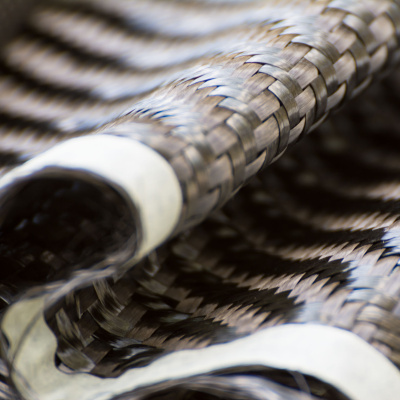Meet Dr Sameer Rahatekar, Research Lecturer in Manufacturing in the Enhanced Composites & Structures Centre…

Dr Rahatekar’s research looks at where plant-based fibres can replace traditional fibres used in manufacturing textiles and engineering components to reduce environmental impact and enhance sustainability.
We interviewed him to find out more.
Can you tell us a little about your role within the Enhanced Composites & Structures Centre, and what your research covers?
“I’m a research lecturer who is part of the manufacturing team working in the Enhanced Composites and Structure Centre. My specific area of work is in biocomposites and nanocomposites, both of which are quite large areas in terms of research and development. One area of my work looks at how naturally-derived, plant-based fibres like hemp or flax can be used to manufacture composites that can be then used in lightweight structures such as wind turbine blades or automotive parts, replacing traditional composites made from metal, carbon fibre or glass fibre. Not only are the natural fibres less heavy but they are also renewable, meaning our work helps industries meet criteria for increasing sustainability and reducing environmental impact, while maintaining good mechanical properties and performance. Another part of our work also looks at how we can make use of natural fibres to make fabrics for clothes.”
What drew you to this area of manufacturing as a career path?
“Before I started working in sustainable manufacturing, I was working on nanocomposites and nanomaterials – which I still do. They have really interesting and high-impact applications in aerospace and, while studying those, I came across a number of natural products and natural materials that I could see that, if used in various industrial sectors such as transport, fashion or biomedical, would reduce environmental pollution and our overall lifestyle would be more sustainable. A lot of the time I see that the development of high-performance technology brings technical advantage, but at a cost to the environment. That doesn’t feel right. There's no point in manufacturing something which is great in terms of its performance, but it's eventually going to hurt the planet and broader environment. So, that was the driving force. It eventually led to research into sustainable ways of manufacturing and setting product design in such a way that we are getting the desired performance while, at the same time, are not polluting and are having as little environmental impact as possible.”
What does a typical day look like for you?
“Even though I’m a research lecturer and I’m supposed to do more research and less teaching, we have a lot of research students so a typical day will include lots of interactions with them in the lab, setting up new experiments. Another big part of it is also writing new plans so that we have the resources to keep on doing what we do.”
Why did you choose to work at Cranfield?
“I was looking for a different career path and what I liked about Cranfield was that its industry connections are much stronger. I’ve been around various universities in the UK and abroad – I was an undergraduate in India, a postgraduate in the UK, and I worked in the US for two years and interacted with universities there. What I like about Cranfield is that our research is not just for the sake of research; there's always drive for implementation of that research for industrial application. I'm not saying Cranfield doesn’t do very good fundamental research, but it's not something we do for the sake of doing it, and I think that’s a good thing. I've seen academics who do really good fundamental research and they are not particularly encouraged to look at applications and societal impact. It’s different here; we have strong industry impact and interaction, and I see that if I do some fundamental research here, it can eventually lead to some sort of industrial impact.”
What is your favourite part of your job?
“Before coming to Cranfield I was in Bristol for many years, where there are lots of undergraduate students. Here we interact specifically with Master’s and PhD students who already have a degree – they’re not here for that. It’s not about trying to retain their attention – they’re asking ‘why’ questions. That’s quite unique.”
Tell me more about your current research.
“Unfortunately, our tendency towards fast fashion means many of the textiles used currently are non-renewable. I’m part of something called a textile circularity centre, which is a circular economy centre funded by UK Research & Innovation (UKRI), where we are looking at manufacturing fibres from crop waste – cellulosic biomass waste – which would otherwise be disposed of through municipal waste. It is biodegradable, but it is of low value. We’re looking at how we can make use of that crop waste and convert it into fashion textiles which otherwise would be manufactured using non-renewables or using cotton, which – although natural – may have a larger environmental footprint because it is one of the most energy-intensive crops and needs lots of fertiliser, pesticides and water to grow.”
Why does this research matter?
“The fashion and clothing industry currently contributes more towards greenhouse gas emissions than the whole of the aviation sector. We want to help cut emissions from this sector, as well as from the road transport sector, to make them more sustainable.”
What will be the real-world impact?
“As well as reducing emissions, using naturally-derived fibres to make lighter weight components for road vehicles will reduce how much fuel they use. In the fashion industry, while UK clothing brands are world famous, we rely on a supply chain outside the UK to produce them and often the people buying the products don’t see the impact of how they got to the clothing shop or high street retail market. We go through that process and try to reduce the environmental footprint of those products.”
Is the research interdisciplinary? If so, how does it bring together the different fields/themes?
“Our work is highly interdisciplinary. It’s at the interface between material science, manufacturing, a bit of chemistry, and then either the automotive or the fashion industry.”
What comes next?
“Over the next 20 years, there will be more and more emphasis on sustainability and reducing the environmental impact of products we use in daily life as well as in the advanced engineering sector. Governments, certainly in the UK and Europe, have recognised that this is the direction in which they want to go – they have put in place directives to cut emissions. There is a strong commitment from governments throughout the world that they want to achieve a green economy and green manufacturing.”
Do you have any advice to offer potential students who are thinking of coming to Cranfield to study natural polymers and composites?
“This is a sector which is quite exciting and, at Cranfield, you are given a lot more lab exposure than at many other institutions I’ve seen. The format is one week of intensive teaching and then you make use of that knowledge in the lab. I think that’s quite a unique opportunity for our students. I also see in myself and the people around me that we are really committed to seeing our students’ careers grow. It’s not just about getting them to come and take the degree. We try to give them individual attention, including in their career development. We try to encourage them to start thinking about career development early on, so they are more focused, and help as many as we can into industry jobs.”
And finally, what do you do when you’re not working?
“I do a bit of reading. I travel. I like going to new places. I like nature, and gardening.”
Supporting information on Dr Sameer Rahatekar and his work
Interested in learning more about Dr Rahatekar’s area of research? Alumni can read recent articles, available through databases in the Alumni Library Online service, on the theme of environmental issues and innovative processing in manufacturing.
Featured paper:
Marta Gina Coscia, Jyoti Bhardwaj, Nandita Singh, M. Gabriella Santonicola, Robert Richardson, Vijay Kumar Thakur, Sameer Rahatekar. (2018). Manufacturing & characterization of regenerated cellulose/curcumin based sustainable composites fibers spun from environmentally benign solvents. Industrial Crops and Products, 111, 536-543.
Read the full text article
For more published papers by Dr Rahatekar, search Cranfield’s repository CERES for his surname.
Articles which have supported Dr Rahatekar’s research:
Hongying Liang, Joel M Friedman & Parimala Nacharaju. (2017) Fabrication of biodegradable PEG–PLA nanospheres for solubility, stabilization, and delivery of curcumin. Artificial Cells, Nanomedicine, and Biotechnology, 45:2, 297-304.
Read the full text article
Z Aytac, T Uyar. (2017). Core-shell nanofibers of curcumin/cyclodextrin inclusion complex and polylactic acid: Enhanced water solubility and slow release of curcumin. International Journal of Pharmaceutics, 518, 177-184.
Full text article
N Zainuddin, I Ahmad, H Kargarzadeh, S Ramli. (2017). Hydrophobic kenaf nanocrystalline cellulose for the binding of curcumin. Carbohydrate Polymers, 163 (2017), 261-269.
Read the full text article
Further reading on environmental issues and innovative processing in the manufacturing of textiles:
ABI-Inform
Heinzel, T. (2020). Human perceptions of recycled textiles and circular fashion: A systematic literature review. Sustainability, 12(24), 10599.
The potential for regenerated protein fibres within a circular economy: Lessons from the past can inform sustainable innovation in the textiles industry. (2021). Sustainability, 13(4), 2328.
Ahmed, S. S., Akter, T., & Ma, Y. (2018). Green supply chain management (GSCM) performance implemented by the textile industry of gazipur district, dhaka. Logistics, 2(4).
Raduly, F. M., Raditoiu, A., & Purcar, V. (2021). Curcumin: Modern applications for a versatile additive. Coatings, 11(5), 519.
Tien, N. D., Lyngstadaas, S. P., Mano, J. F., Blaker, J. J., & Haugen, H. (2021). Recent developments in chitosan-based Micro/Nanofibers for sustainable food packaging, smart textiles, cosmeceuticals, and biomedical applications. Molecules, 26(9), 2683.
Emerald Journals
Gaffer, H., Mashaly, H., Abdel-Rhman, S.H. and Hammouda, M. (2017). Synthesis of novel dyes based on curcumin for the creation of antibacterial silk fabrics. Pigment & Resin Technology, 46(6), 478-484.
Hack-Polay, D., Rahman, M., Billah, M.M. and Al-Sabbahy, H.Z. (2020). Big data analytics and sustainable textile manufacturing: Decision-making about the applications of biotechnologies in developing countries. Management Decision, 58(8), 1699-1714.
Islam, M.M., Perry, P. and Gill, S. (2021). Mapping environmentally sustainable practices in textiles, apparel and fashion industries: a systematic literature review. Journal of Fashion Marketing and Management, 25(2), 331-353.
Abreu, M.C.S.d., Ferreira, F.N.H., Proença, J.F. and Ceglia, D. (2020). Collaboration in achieving sustainable solutions in the textile industry. Journal of Business & Industrial Marketing, Ahead-of-print.
Sage Journals
Yang, Y., Zhang, M., Ju, Z., Tam, P. Y., Hua, T., Younas, M. W., Kamrul, H., & Hu, H. (2021). Poly(lactic acid) fibers, yarns and fabrics: Manufacturing, properties and applications. Textile Research Journal.
Sajid, L., Azmami, O., El ahmadi, Z., Benayada, A., & Gmouh, S. (2019). Extraction and characterization of palm fibers and their use to produce wool- and polyester-blended nonwovens. Journal of Industrial Textiles.
Janarthanan, M., & Senthil Kumar, M. (2018). The properties of bioactive substances obtained from seaweeds and their applications in textile industries. Journal of Industrial Textiles, 48(1), 361–401.
Vázquez-Núñez, E., Avecilla-Ramírez, A. M., Vergara-Porras, B., & López-Cuellar, M. del R. (2021). Green composites and their contribution toward sustainability: A review. Polymers and Polymer Composites.
New to the ALO? Follow these simple steps to access your Alumni Library Online service:
- Go to your alumni portal
- Log in with your details
- Scroll down the page and click on Alumni Library Online
- Click on Databases to find the databases listed above.
Forgotten your portal login?
Please email the Alumni team.
Any other questions?
Contact your ALO team.


